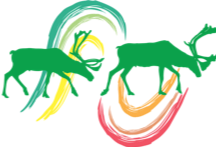Determining Herd Status
Photo: John Nagy
The Monitoring Table
Caribou herd populations vary over time, with periods of abundance and periods of scarcity. The size of a herd and the health of its animals are influenced by factors that can work in combination. Through carefully designed monitoring programs and traditional and local knowledge, communities and scientists can collect information about changes in the herds and in the ecological factors that affect caribou numbers and health.
Using information collected from both scientific and traditional/local knowledge, the ACCWM discusses herd status according to the ten factors in the adjacent table.
The “Traffic Light” Approach
The Taking Care of Caribou Plan defines four herd status levels. Each herd status triggers specific management actions, which are related to the natural population cycles as well as cumulative effects on the herds.
The ACCWM determines the status of each of the herds at its Annual Status Meeting in November of each year. Each of the wildlife management boards/councils collects input on the status table from their communities with annual in-person consultations. Thus, the ACCWM considers the best available information, including scientific knowledge and up to date community observations, on each of the factors listed above and the interactions between them. Herd status is determined by consensus and action plans for each herd follow.
Herd status
Population Thresholds
Approximate numerical thresholds between herd statuses are defined in the management plan. The thresholds are approximate and are used to help guide management decisions and actions, and the numbers are used in combination with traditional and local knowledge and other scientific knowledge on every category in the monitoring table.
Monitoring Caribou
Community Monitoring
“It would be useful to have something that encourages hunter feedback about where caribou are, and what condition they are in.”
Monitoring is a familiar concept to Indigenous people, who have traditionally monitored both herds and socio-cultural practices related to harvesting and other experiences on the land. When hunting, people observe caribou, their ecosystem, and their physical environment, according to a number of criteria based on their traditional law. New information is interpreted in the context of stories and knowledge passed down through generations and shared within and across communities. From a community perspective, monitoring includes not only observations of caribou, but other discussions about what is taking place on the land, such as harvesting and sharing practices.
Monitoring is thus conducted by communities in their day-to-day interactions on the land, as well as through specific projects and initiatives to systematically gather information according to traditional ways of knowing, such as the example below.
“I was raised on the land and grew up with the caribou. I was taught how to look after my hunting and take what I have to. I was taught on the land. The caribou is a really sensitive animal and we do respect it.”
Scientific Monitoring
The GNWT uses two methods to monitor barren-ground caribou herds while they are aggregated on calving and post-calving grounds in the spring. The methods are considered comparable.
For the last fifty years, the Department of Environment and Natural Resources has been tracking changes in caribou population cycles together with co-management partners. The calving ground photo survey is used for the Bluenose-East herd.
The post-calving photo survey is used for the Cape Bathurst and Bluenose-West herds.





